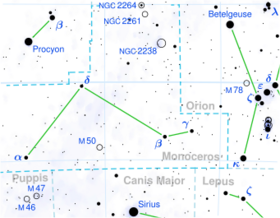Astronomy:17 Monocerotis
From HandWiki
Short description: Star in the constellation Monoceros
| Observation data Equinox J2000.0]] (ICRS) | |
|---|---|
| Constellation | Monoceros |
| Right ascension | 06h 47m 19.82946s[1] |
| Declination | 8° 02′ 14.1239″[1] |
| Apparent magnitude (V) | 4.77[2] |
| Characteristics | |
| Spectral type | K4 III[3] |
| U−B color index | +1.65[2] |
| B−V color index | +1.40[2] |
| Astrometry | |
| Radial velocity (Rv) | +46.19[4] km/s |
| Proper motion (μ) | RA: -23.728[1] mas/yr Dec.: -12.011[1] mas/yr |
| Parallax (π) | 6.62 ± 0.25[1] mas |
| Distance | 490 ± 20 ly (151 ± 6 pc) |
| Absolute magnitude (MV) | -1.12[5] |
| Details | |
| Radius | 25+1 −3[1] R☉ |
| Luminosity | 538.2±23.8[1] L☉ |
| Surface gravity (log g) | 1.86[6] cgs |
| Temperature | 4,345[7] K |
| Metallicity [Fe/H] | +0.06[5] dex |
| Rotational velocity (v sin i) | 2.5[8] km/s |
| Other designations | |
| Database references | |
| SIMBAD | data |
17 Monocerotis is a single[9] star located around 490[1] light years away from the Sun in the equatorial constellation of Monoceros. It is visible to the naked eye as a faint, orange-hued star with an apparent visual magnitude of 4.77.[2] The star is moving away from the Earth with a heliocentric radial velocity of +46 km/s.[4]
This is an aging giant star with a stellar classification of K4 III.[3] As a consequence of having exhausted the supply of hydrogen at its core, the star has expanded to 25[1] times the radius of the Sun. It is radiating around 538[1] times the Sun's luminosity from its swollen photosphere at an effective temperature of 4,345 K.[7]
References
- ↑ 1.0 1.1 1.2 1.3 1.4 1.5 1.6 1.7 1.8 1.9 Brown, A. G. A. (August 2018). "Gaia Data Release 2: Summary of the contents and survey properties". Astronomy & Astrophysics 616: A1. doi:10.1051/0004-6361/201833051. Bibcode: 2018A&A...616A...1G. Gaia DR2 record for this source at VizieR.
- ↑ 2.0 2.1 2.2 2.3 Ducati, J. R. (2002). "VizieR Online Data Catalog: Catalogue of Stellar Photometry in Johnson's 11-color system". CDS/ADC Collection of Electronic Catalogues 2237. Bibcode: 2002yCat.2237....0D.
- ↑ 3.0 3.1 Hoffleit, D.; Warren, W. H. (1995). "VizieR Online Data Catalog: Bright Star Catalogue, 5th Revised Ed. (Hoffleit+, 1991)". VizieR On-line Data Catalog: V/50. Originally Published in: 1964BS....C......0H 5050. Bibcode: 1995yCat.5050....0H.
- ↑ 4.0 4.1 Famaey, B.; Jorissen, A.; Luri, X.; Mayor, M.; Udry, S.; Dejonghe, H.; Turon, C. (2005). "Local kinematics of K and M giants from CORAVEL/Hipparcos/Tycho-2 data". Astronomy & Astrophysics 430: 165–186. doi:10.1051/0004-6361:20041272. Bibcode: 2005A&A...430..165F.
- ↑ 5.0 5.1 Anderson, E.; Francis, Ch. (2012). "XHIP: An extended hipparcos compilation". Astronomy Letters 38 (5): 331. doi:10.1134/S1063773712050015. Bibcode: 2012AstL...38..331A. Vizier catalog entry
- ↑ Soubiran, Caroline; Le Campion, Jean-François; Brouillet, Nathalie; Chemin, Laurent (2016). "The PASTEL catalogue: 2016 version". Astronomy & Astrophysics 591: A118. doi:10.1051/0004-6361/201628497. Bibcode: 2016A&A...591A.118S.
- ↑ 7.0 7.1 McDonald, I.; Zijlstra, A. A.; Boyer, M. L. (2012). "Fundamental parameters and infrared excesses of Hipparcos stars". Monthly Notices of the Royal Astronomical Society 427 (1): 343–357. doi:10.1111/j.1365-2966.2012.21873.x. Bibcode: 2012MNRAS.427..343M. Vizier catalog entry
- ↑ De Medeiros, J. R.; Mayor, M. (1999). "A catalog of rotational and radial velocities for evolved stars". Astronomy and Astrophysics Supplement Series 139 (3): 433. doi:10.1051/aas:1999401. Bibcode: 1999A&AS..139..433D. Vizier catalog entry
- ↑ Eggleton, P. P.; Tokovinin, A. A. (September 2008). "A catalogue of multiplicity among bright stellar systems". Monthly Notices of the Royal Astronomical Society 389 (2): 869–879. doi:10.1111/j.1365-2966.2008.13596.x. Bibcode: 2008MNRAS.389..869E.
 |


